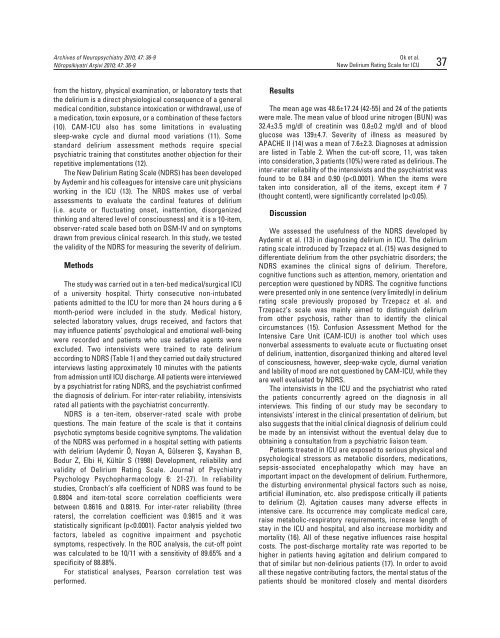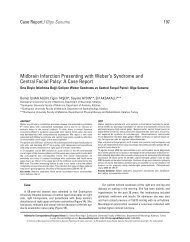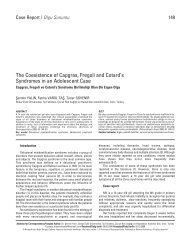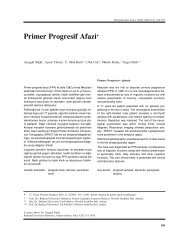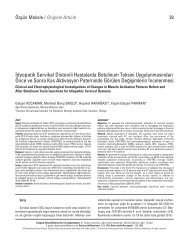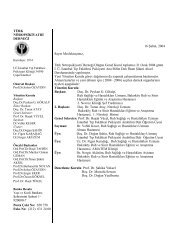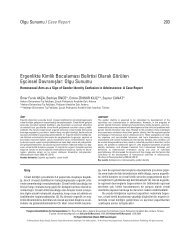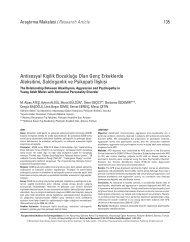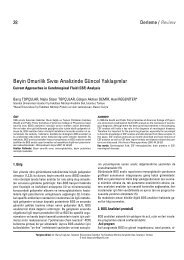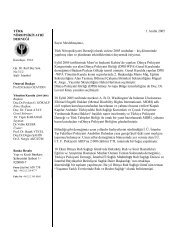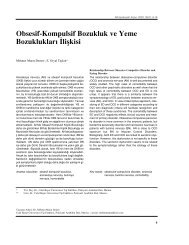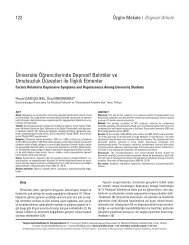New Delirium Rating Scale for ICU - Nöropsikiyatri ArÅivi Dergisi
New Delirium Rating Scale for ICU - Nöropsikiyatri ArÅivi Dergisi
New Delirium Rating Scale for ICU - Nöropsikiyatri ArÅivi Dergisi
Create successful ePaper yourself
Turn your PDF publications into a flip-book with our unique Google optimized e-Paper software.
Archives of Neuropsychiatry 2010; 47: 36-9<br />
Nöropsikiyatri Arflivi 2010; 47: 36-9<br />
Ok et al.<br />
<strong>New</strong> <strong>Delirium</strong> <strong>Rating</strong> <strong>Scale</strong> <strong>for</strong> <strong>ICU</strong> 37<br />
from the history, physical examination, or laboratory tests that<br />
the delirium is a direct physiological consequence of a general<br />
medical condition, substance intoxication or withdrawal, use of<br />
a medication, toxin exposure, or a combination of these factors<br />
(10). CAM-<strong>ICU</strong> also has some limitations in evaluating<br />
sleep-wake cycle and diurnal mood variations (11). Some<br />
standard delirium assessment methods require special<br />
psychiatric training that constitutes another objection <strong>for</strong> their<br />
repetitive implementations (12).<br />
The <strong>New</strong> <strong>Delirium</strong> <strong>Rating</strong> <strong>Scale</strong> (NDRS) has been developed<br />
by Aydemir and his colleagues <strong>for</strong> intensive care unit physicians<br />
working in the <strong>ICU</strong> (13). The NRDS makes use of verbal<br />
assessments to evaluate the cardinal features of delirium<br />
(i.e. acute or fluctuating onset, inattention, disorganized<br />
thinking and altered level of consciousness) and it is a 10-item,<br />
observer-rated scale based both on DSM-IV and on symptoms<br />
drawn from previous clinical research. In this study, we tested<br />
the validity of the NDRS <strong>for</strong> measuring the severity of delirium.<br />
Methods<br />
The study was carried out in a ten-bed medical/surgical <strong>ICU</strong><br />
of a university hospital. Thirty consecutive non-intubated<br />
patients admitted to the <strong>ICU</strong> <strong>for</strong> more than 24 hours during a 6<br />
month-period were included in the study. Medical history,<br />
selected laboratory values, drugs received, and factors that<br />
may influence patients’ psychological and emotional well-being<br />
were recorded and patients who use sedative agents were<br />
excluded. Two intensivists were trained to rate delirium<br />
according to NDRS (Table 1) and they carried out daily structured<br />
interviews lasting approximately 10 minutes with the patients<br />
from admission until <strong>ICU</strong> discharge. All patients were interviewed<br />
by a psychiatrist <strong>for</strong> rating NDRS, and the psychiatrist confirmed<br />
the diagnosis of delirium. For inter-rater reliability, intensivists<br />
rated all patients with the psychiatrist concurrently.<br />
NDRS is a ten-item, observer-rated scale with probe<br />
questions. The main feature of the scale is that it contains<br />
psychotic symptoms beside cognitive symptoms. The validation<br />
of the NDRS was per<strong>for</strong>med in a hospital setting with patients<br />
with delirium (Aydemir Ö, Noyan A, Gülseren fi, Kayahan B,<br />
Bodur Z, Elbi H, Kültür S (1998) Development, reliability and<br />
validity of <strong>Delirium</strong> <strong>Rating</strong> <strong>Scale</strong>. Journal of Psychiatry<br />
Psychology Psychopharmacology 6: 21-27). In reliability<br />
studies, Cronbach’s alfa coefficient of NDRS was found to be<br />
0.8804 and item-total score correlation coefficients were<br />
between 0.8616 and 0.8819. For inter-rater reliability (three<br />
raters), the correlation coefficient was 0.9815 and it was<br />
statistically significant (p


